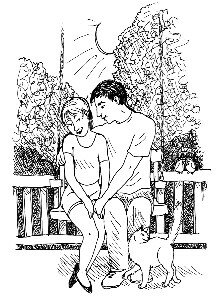STRANGE BUT TRUE- In spring: Young man's fancy turns to...

Q. Why is spring/summer such a grand time for romance– April love, June brides, moonlight and roses? P. Boone
A. The seasonal increase in love and marriage, in some cultures, probably arises from the better weather, blossomings, animals breeding, sense of renewal, says University at Buffalo behavioral neuroscientist Mark B. Kristal. After the winter, the sunshine is invigorating, as is the lighter clothing, more vitamin D, exercise, etc., making people feel healthier and therefore sexier.
With warmer months and better moods comes enhanced socializing, bringing on even better moods. Now we want to engage with the world and enjoy its rewards, says Australian clinical psychologist Greg Murray. This High Positive Affect has been characterized as the "two-beer effect"– after you consume two beers, the bartender starts to look like a potential life partner.
Social psychologists say that all it takes is a sunny day to bring out more smiles, greater willingness to play the Good Samaritan, bigger tips for servers, and a score of
other nicenesses. So why not a greater readiness to give one's heart away during the seasons of lengthening days and lavish light?
Let there be love!
Q. What are a few weird things to be discovered about the human body during a first (or 100th, for that matter) human cadaver dissection in "gross anatomy" class? –M. Shelley
A. The "gross" here refers to size– "visible without the aid of a microscope," says anatomy prof James Rhodes. The grossest thing encountered in a lab is probably the smell of phenol and formaldehyde used for embalming, which makes dissection easier. Queasiness is common, particularly when dissecting the hands and face, though it helps to keep one's mind on the noble act of the body donor in service of education.
Most striking revelation is probably the variability from body to body, such as wide difference in vascular supply to parts like the heart, something surgeons must be
acutely aware of in the living, says Marquette University's Robert Iorio. Nerve supplies also vary, a challenge to neurologists trying to assess nerve damage. Occasionally "extra" muscles are found at autopsy, especially in the thorax, or "extra" bones possibly in the skull; or one of the two kidneys may never have developed.
Countless intestinal arrangements are also possible, and as Guy Murchie points out in The Seven Mysteries of Life, ordinary adult stomachs can look round, oblong, bean- shaped, etc– some holding 15 times as much food as others! So for us humans, dead or alive, variability is normal.
Q. Videocam your infant daughter's face for a week, through mood highs and lows, and how many distinct emotional expressions might you capture? –J. Fariello
A. Expect to spot joy– mouth smiling, cheeks lifted, twinkle in the eye– anger, fear, sadness, surprise, interest, and disgust–nose wrinkled, upper lip raised, tongue pushed outward– says David G. Myers in Psychology, drawing on the work of Carroll Izard.
These natural seven are there in Baby from birth, recognizable in cultures worldwide, the number later growing to include contempt, shame, guilt, and maybe love. Other emotions may be combinations of these 10. In almost all cases, the expression and emotion are intertwined, with the expression actually heightening the feeling, called "facial feedback": how happy that a doting Mom (or Dad), when
smiling at Baby, not only expresses her joy but feels it more; and that Baby, beaming back the same, helps tighten empathic bonds through up-close mother-and-child facial mimicry!
Q. What's special about a number like 69,696? –S. Aller
A. This is an "undulating number," of the form ababababab... says Clifford Pickover in Keys to Infinity. There are any number of such numbers, such as 171,717 and
28,282. A special feature of 69,696 is that it is also a square number– 264 squared– an "undulating square," in fact– possibly the largest undulating square. This last point is
far from certain, though one numbers hunter in Germany asserts that if there is a larger undulating square, it must have more than a million digits.
Says Pickover, 69,696 is "certainly my favorite of all the integers, a remarkable number" that is almost exactly equal to the average velocity in miles per hour of the Earth in orbit and to the surface temperature in degrees Fahrenheit of some of the hottest stars. And if that doesn't get you undulating with excitement or something...
Send Strange questions to brothers Bill and Rich at [email protected].
#